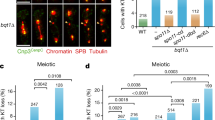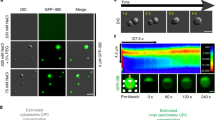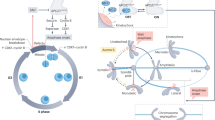Abstract
The anaphase promoting complex/cyclosome (APC/C) is crucial to the control of cell division (for a review, see ref. 1). It is a multi-subunit ubiquitin ligase that, at defined points during mitosis, targets specific proteins for proteasomal degradation. The APC/C is itself regulated by the spindle or kinetochore checkpoint, which has an important role in maintaining genomic stability by preventing sister chromatid separation until all chromosomes are correctly aligned on the mitotic spindle. The spindle checkpoint regulates the APC/C by inactivating Cdc20, an important co-activator of the APC/C. There is also evidence to indicate that the spindle checkpoint components and Cdc20 are spatially regulated by the mitotic apparatus, in particular they are recruited to improperly attached kinetochores. Here, we show that the APC/C itself co-localizes with components of the spindle checkpoint to improperly attached kinetochores. Indeed, we provide evidence that the spindle checkpoint machinery is required to recruit the APC/C to kinetochores. Our data indicate that the APC/C could be regulated directly by the spindle checkpoint.
This is a preview of subscription content, access via your institution
Access options
Subscribe to this journal
Receive 12 print issues and online access
$209.00 per year
only $17.42 per issue
Buy this article
- Purchase on Springer Link
- Instant access to full article PDF
Prices may be subject to local taxes which are calculated during checkout





Similar content being viewed by others
References
Peters, J.M. The anaphase-promoting complex: proteolysis in mitosis and beyond. Mol. Cell 9, 931–943 (2002).
Clute, P. & Pines, J. Temporal and spatial control of cyclin B1 destruction in metaphase. Nature Cell Biol. 1, 82–87 (1999).
Huang, J. & Raff, J.W. The disappearance of cyclin B at the end of mitosis is regulated spatially in Drosophila cells. EMBO J. 18, 2184–2195 (1999).
Raff, J.W., Jeffers, K. & Huang, J.Y. The roles of Fzy/Cdc20 and Fzr/Cdh1 in regulating the destruction of cyclin B in space and time. J. Cell Biol. 157, 1139–1149 (2002).
Yoon, H.J. et al. Proteomics analysis identifies new components of the fission and budding yeast anaphase-promoting complexes. Curr. Biol. 12, 2048–2054 (2002).
Tugendreich, S., Tomkiel, J., Earnshaw, W. & Hieter, P. CDC27Hs colocalizes with CDC16Hs to the centrosome and mitotic spindle and is essential for the metaphase to anaphase transition. Cell 81, 261–268 (1995).
Jorgensen, P.M., Brundell, E., Starborg, M. & Hoog, C. A subunit of the anaphase-promoting complex is a centromere-associated protein in mammalian cells. Mol. Cell. Biol. 18, 468–476 (1998).
Kurasawa, Y. & Todokoro, K. Identification of human APC10/Doc1 as a subunit of anaphase promoting complex. Oncogene 18, 5131–5137 (1999).
Topper, L.M. et al. The dephosphorylated form of the anaphase-promoting complex protein Cdc27/Apc3 concentrates on kinetochores and chromosome arms in mitosis. Cell Cycle 1, 282–292 (2002).
Huang, J.Y. & Raff, J.W. The dynamic localisation of the Drosophila APC/C: evidence for the existence of multiple complexes that perform distinct functions and are differentially localised. J. Cell Sci. 115, 2847–2856 (2002).
Kraft, C. et al. Mitotic regulation of the human anaphase-promoting complex by phosphorylation. EMBO J. 22, 6598–6609 (2003).
Waters, J.C. et al. Mad2 binding by phosphorylated kinetochores links error detection and checkpoint action in mitosis. Curr. Biol. 9, 649–652 (1999).
Nicklas, R.B., Ward, S.C. & Gorbsky, G.J. Kinetochore chemistry is sensitive to tension and may link mitotic forces to a cell cycle checkpoint. J. Cell Biol. 130, 929–939 (1995).
Musacchio, A. & Hardwick, K.G. The spindle checkpoint: structural insights into dynamic signalling. Nature Rev. Mol. Cell Biol. 3, 731–741 (2002).
Gorbsky, G.J. Cell cycle checkpoints: arresting progress in mitosis. Bioessays 19, 193–197 (1997).
Rieder, C.L., Cole, R.W., Khodjakov, A. & Sluder, G. The checkpoint delaying anaphase in response to chromosome monoorientation is mediated by an inhibitory signal produced by unattached kinetochores. J. Cell Biol. 130, 941–948 (1995).
Hagting, A. et al. Human securin proteolysis is controlled by the spindle checkpoint and reveals when the APC/C switches from activation by Cdc20 to Cdh1. J. Cell Biol. 157, 1125–1137 (2002).
Howell, B.J., Hoffman, D.B., Fang, G., Murray, A.W. & Salmon, E.D. Visualization of Mad2 dynamics at kinetochores, along spindle fibers, and at spindle poles in living cells. J. Cell Biol. 150, 1233–1250 (2000).
Shah, J.V. et al. Dynamics of centromere and kinetochore proteins; implications for checkpoint signaling and silencing. Curr. Biol. 14, 942–952 (2004).
Howell, B.J. et al. Spindle checkpoint protein dynamics at kinetochores in living cells. Curr. Biol. 14, 953–964 (2004).
Howell, B.J. et al. Cytoplasmic dynein/dynactin drives kinetochore protein transport to the spindle poles and has a role in mitotic spindle checkpoint inactivation. J. Cell Biol. 155, 1159–1172 (2001).
Gieffers, C., Dube, P., Harris, J.R., Stark, H. & Peters, J.M. Three-dimensional structure of the anaphase-promoting complex. Mol. Cell 7, 907–913 (2001).
Taylor, S.S. & McKeon, F. Kinetochore localization of murine Bub1 is required for normal mitotic timing and checkpoint response to spindle damage. Cell 89, 727–735 (1997).
Skoufias, D.A., Andreassen, P.R., Lacroix, F.B., Wilson, L. & Margolis, R.L. Mammalian mad2 and bub1/bubR1 recognize distinct spindle-attachment and kinetochore-tension checkpoints. Proc. Natl Acad. Sci. USA 98, 4492–4497 (2001).
Ditchfield, C. et al. Aurora B couples chromosome alignment with anaphase by targeting BubR1, Mad2, and Cenp-E to kinetochores. J. Cell Biol. 161, 267–280 (2003).
Hauf, S. et al. The small molecule Hesperadin reveals a role for Aurora B in correcting kinetochore-microtubule attachment and in maintaining the spindle assembly checkpoint. J. Cell Biol. 161, 281–294 (2003).
Taylor, S.S., Hussein, D., Wang, Y., Elderkin, S. & Morrow, C.J. Kinetochore localisation and phosphorylation of the mitotic checkpoint components Bub1 and BubR1 are differentially regulated by spindle events in human cells. J. Cell Sci. 114, 4385–4395 (2001).
Sudakin, V., Chan, G.K. & Yen, T.J. Checkpoint inhibition of the APC/C in HeLa cells is mediated by a complex of BUBR1, BUB3, CDC20, and MAD2. J. Cell Biol. 154, 925–936 (2001).
Gorbsky, G.J., Chen, R.H. & Murray, A.W. Microinjection of antibody to Mad2 protein into mammalian cells in mitosis induces premature anaphase. J. Cell Biol. 141, 1193–1205 (1998).
Thornton, B.R. & Toczyski, D.P. Securin and B-cyclin/CDK are the only essential targets of the APC. Nature Cell Biol. 5, 1090–1094 (2003).
Koloteva-Levine, N. et al. The Apc5 subunit of the anaphase-promoting complex/cyclosome interacts with poly(A) binding protein and represses internal ribosome entry site-mediated translation. Mol. Cell Biol. 24, 3577–3587 (2004).
Andrews, P.D. et al. Aurora B regulates MCAK at the mitotic centromere. Dev. Cell 6, 253–268 (2004).
Gorbsky, G.J. & Ricketts, W.A. Differential expression of a phosphoepitope at the kinetochores of moving chromosomes. J. Cell Biol. 122, 1311–1321 (1993).
Daum, J.R. et al. The 3F3/2 anti-phosphoepitope antibody binds the mitotically phosphorylated anaphase-promoting complex/cyclosome. Curr. Biol. 10, R850–R852 (2000).
Yamano, H., Gannon, J., Mahbubani, H. & Hunt, T. Cell cycle-regulated recognition of the destruction box of cyclin B by the APC/C in Xenopus egg extracts. Mol. Cell 13, 137–147 (2004).
Vigneron, S., Prieto, S., Bernis, C., Labbe, J.C., Castro, A. & Lorca, T. Kinetochore localization of spindle checkpoint proteins: who controls whom? Mol. Biol. Cell DOI: 10.1091/mbc.E04-010051 (2004).
Acknowledgements
We are grateful to N. Keen for the Aurora inhibitors; to T. Lorca for communicating results before publication; to J.-M. Peters for his generosity; to H. Vodermaier for valuable reagents and discussions; to A. Sossick for help with deconvolution; to B. Earnshaw, T. Salmon, J.-M. Peters and our colleagues in the laboratory for discussions; and to A. Hagting, C. Lindon, L. Clay and R. Basto for comments on the manuscript. C.A. was supported by an EU TMR network grant (contract number QLG1-CT-2001-02026), and the research was funded by Programme Grant C29/A1782 to J.P. from Cancer Research UK.
Author information
Authors and Affiliations
Corresponding author
Ethics declarations
Competing interests
The authors declare no competing financial interests.
Supplementary information
Supplementary Information, Figures
Fig. S1, Fig. S2, Fig. S3, Fig. S4 and Fig. S5 (PDF 493 kb)
Rights and permissions
About this article
Cite this article
Acquaviva, C., Herzog, F., Kraft, C. et al. The anaphase promoting complex/cyclosome is recruited to centromeres by the spindle assembly checkpoint. Nat Cell Biol 6, 892–898 (2004). https://doi.org/10.1038/ncb1167
Received:
Accepted:
Published:
Issue Date:
DOI: https://doi.org/10.1038/ncb1167
This article is cited by
-
Bub1 positions Mad1 close to KNL1 MELT repeats to promote checkpoint signalling
Nature Communications (2017)
-
PATRONUS1 is expressed in meiotic prophase I to regulate centromeric cohesion in Arabidopsis and shows synthetic lethality with OSD1
BMC Plant Biology (2015)
-
Spatiotemporal regulation of the anaphase-promoting complex in mitosis
Nature Reviews Molecular Cell Biology (2015)
-
Ubiquitin-specific protease 22 is a deubiquitinase of CCNB1
Cell Discovery (2015)
-
Spatial-temporal model for silencing of the mitotic spindle assembly checkpoint
Nature Communications (2014)



